Dell XPS 15 (2020) Review
Dell XPS 15 (2020) Review
The world's best laptop just got bigger and stronger
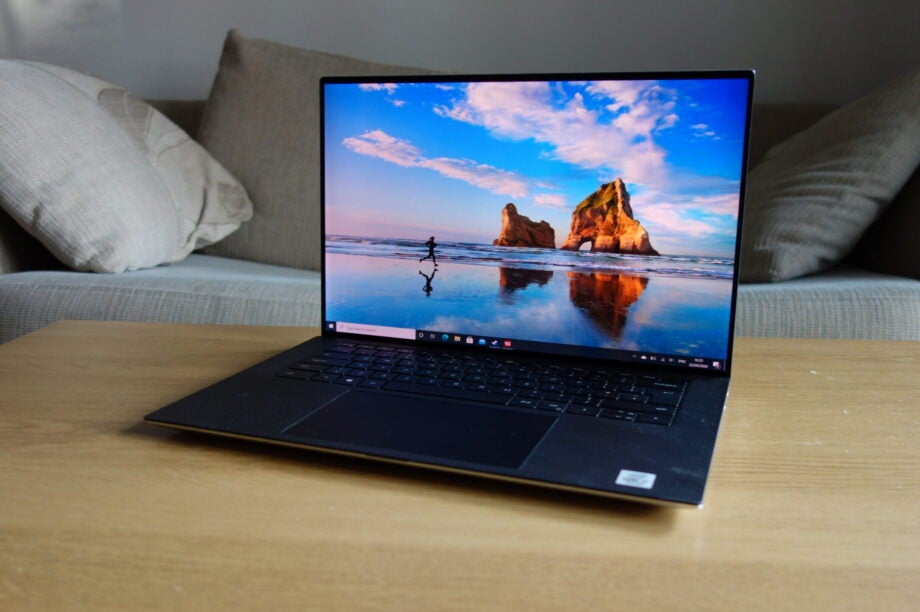
Verdict
The Dell XPS 15 (2020) is one of the absolute best 15-inch laptops you can buy, with the design, screen and keyboard all boasting industry-leading quality. However, the lack of high-end GPU options mean you may be better off with a MacBook Pro or gaming laptop than spending big on one of the £2000+ configurations.
Pros
- Unrivalled stylish looks
- 4K screen is a beauty
- Comfortable keyboard
- Good battery life
Cons
- Limited graphics power
- Stingy port offering
Key Specifications
- Review Price: £2249
- 15.6-inch Full HD/4K, 16:10
- Up to 10th Gen Intel Core i9
- Up to 64GB RAM
- Up to Nvidia GTX 1650 Ti graphics
- Up to 1TB SSD
- Dimensions: 345 x 230 x 18 mm
- Weight: From 1.83kg
The Dell XPS 15 2020 is essentially the super-sized twin of the award-winning XPS 13, retaining the gorgeous edge-to-edge screen, but fitting more powerful components inside the larger clamshell design.
While the XPS 13 prioritised portability above all else, the XPS 15 is more focused on power. With a GTX 1650 Ti GPU and Intel’s high-performance 10th Gen processors, this Dell is a very versatile machine that can accomplish most computing tasks.
The GPU grunt is not quite powerful enough to challenge the likes of the MacBook Pro, but the Dell XPS 15 is still one of the absolute best laptops currently on sale.
Design – No-bezel beauty
- The Dell XPS 15 is one of the best looking laptops I’ve reviewed
- The 1.8kg is quite hefty, but not atypical for a 15-inch laptop
- No USB-A port, but Dell has included an adaptor
Super-skinny designs are usually reserved for 13-inch laptops, but Dell has managed to give the new XPS 15 a wafer-thin 18mm chassis, which is only 4mm taller than the Dell XPS 13 2020.
It’s an incredible feat, making it easier to store the laptop away in a bag or cupboard, while also giving it breath-taking glamour. This is the best looking 15-inch laptop I’ve ever seen, especially with its edge-to-edge InfinityEdge screen that essentially squeezes the bezel out of existence.
While most laptop rivals have also introduced a teeny bezel, Dell has been one of the very first to eradicate the laptop’s chin entirely, resulting in a taller display that’s rocking a 16:10 aspect ratio. This isn’t well optimised for video content, seeing black bars appear on the top and bottom of the screen for the likes of Netflix and YouTube, but it’s hardly noticeable. On the plus side, you’re afforded more screen space for the web browser to squeeze in more lines of text.
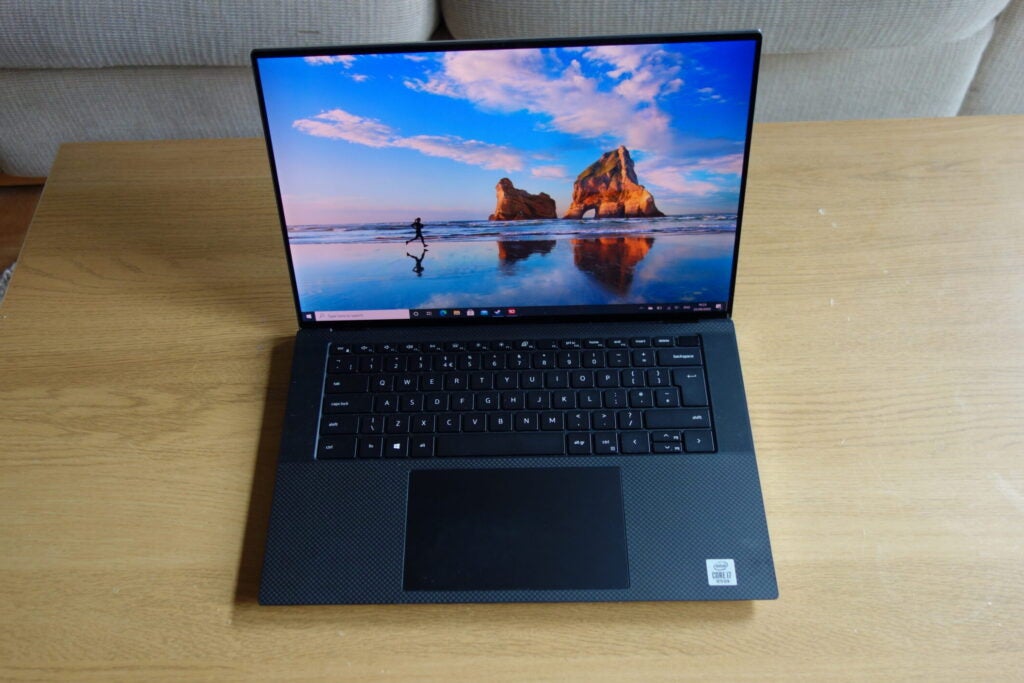
The carbon fibre on the deck of the laptop is comfortable to rest your palms on, and looks fantastic. The patterned carbon fiber chassis may look simple, but it helps provide some distinctive personality. The laptop feels sturdy too, snubbing plastic for an all-metal body.
Despite being so thin, the Dell XPS 15 isn’t the lightest laptop available. Weighing in at 1.8kg (and 2.05 kg for the touchscreen model) it’s roughly just as heavy as you’d expect for a 15-inch laptop. This means the smaller XPS 13 is significantly lighter, so may be the better option if portability is your priority.
The XPS 15 is more about power, and so it’s therefore a shame that it’s been stingy on the port front, featuring two Thunderbolt 3, one USB-C 3.1, a full-size SD card reader and a headphone jack. There’s no room for the traditional USB-A port here, with Dell arguing its laptop is simply too skinny to accommodate the ageing technology.
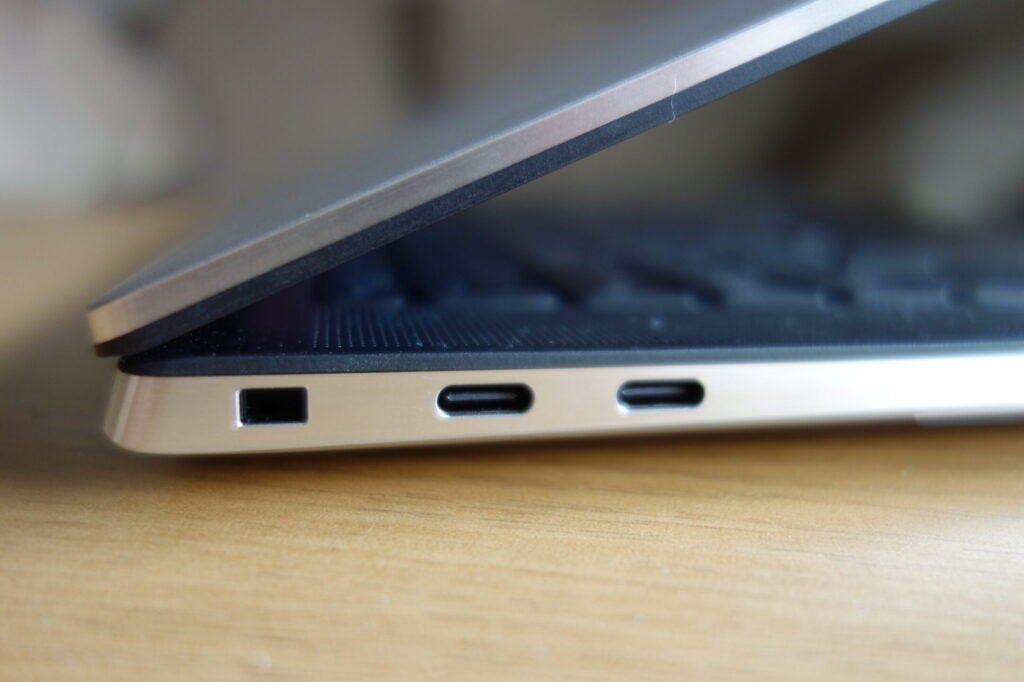
The USB-A’s future is no doubt numbered, but that doesn’t help the numerous people still using accessories and USB sticks that still require the format. Dell has at least bundled a USB-C to USB-A adapter (which also features a HDMI port) in the box, but that will still understandably be frustrating is you frequently use a USB mouse.
Up-firing speakers can be found on either side of the keyboard, providing detailed and bassy sound that can be whacked up to a surprising decibel. The XPS 15 has the best speakers in a laptop I’ve tested yet, making this laptop a superb substitute to your Bluetooth speakers.
The webcam is decent, nestled in the top bezel despite the limited room available. The 720p camera doesn’t offer the greatest capture quality, but it’s comfortably competent enough for business conferences and friendly Zoom catch ups.
Keyboard – Top-class keys ensure comfortable typing
- One of the best laptop keyboards you can find
- Fingerprint scanner baked into power key
- Glass trackpad is even larger than before
Dell knows how to make a good laptop keyboard, so it’s no surprise that the XPS 15 excels in this area. The keys feature deep travel, have a subtle clicky press for satisfying feedback and are reasonably sized to avoid typos.
There’s no number pad here, but I personally think that’s a good thing, as other keys haven’t needed to be squashed down or shunted to a corner to accommodate space for keys that a large majority of users don’t need. The vertical arrow keys have unfortunately been slimmed down though.
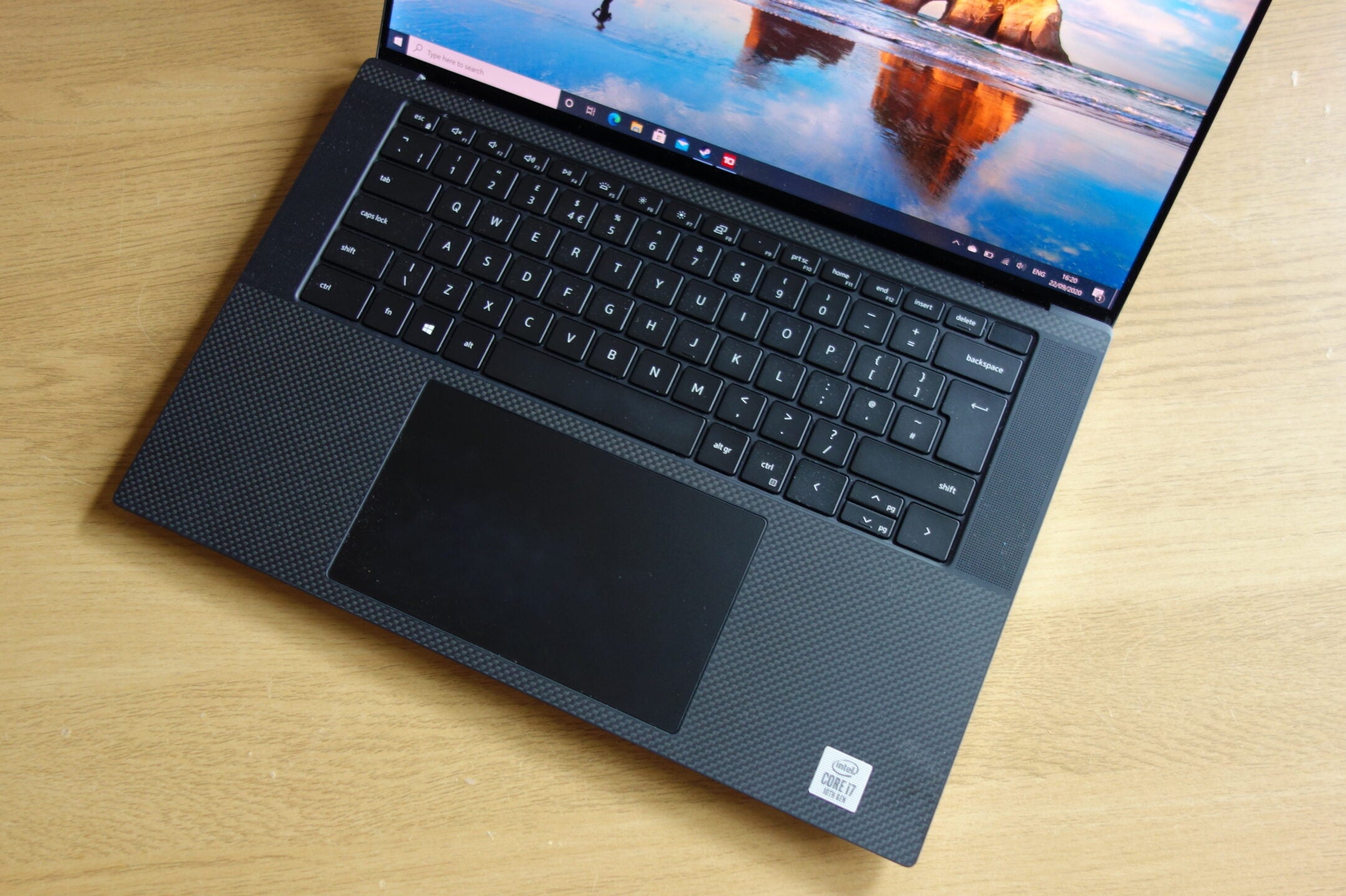
The XPS 15 features a fingerprint scanner that’s baked into the power button, and an IR scanner for facial recognition. Both options can be used to unlock your laptop, avoiding precious seconds of recalling your password.
Dell has increased the trackpad by 15% compared to the preceding iteration, making it absolutely massive. I’m a big fan of this, as it’s considerably more comfortable to glide your fingers across the surface without hitting the sides. It’s also as responsive as you could ask for.
Screen – Best laptop display yet
- 4K panels looks absolutely beautiful (FHD optional too)
- 16:10 aspect ratio is ideal for web browsing and spreadsheets
- Colour coverage is good enough for professional-grade work
The Dell XPS 15 (2020) has two 15.6-inch screen options: a non-touch Full HD panel and a touchscreen 4K display. Dell sent me the latter, and it is absolutely gorgeous.
The bright 400-nit display is bursting with sharp colours, while the superb 1236:1 contrast ensures bright lights stand out vividly from the darker shades. I watched a few 4K shows on Netflix, including a couple of Attenborough documentaries, and was seriously impressed by the detailed images on display.
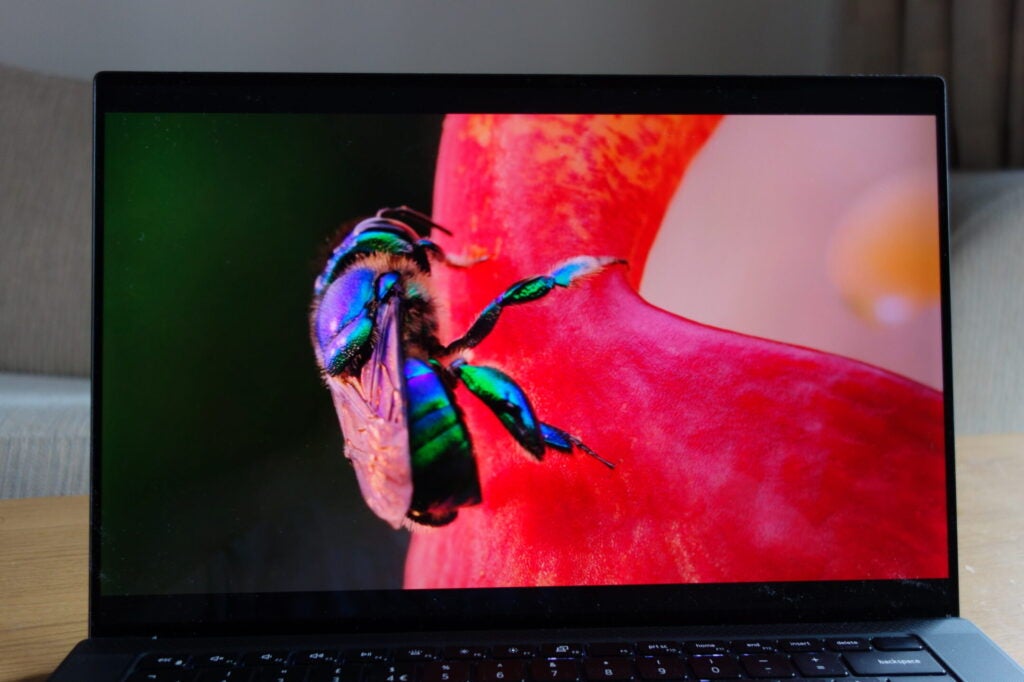
The 4K panel is also of a good enough standard for professional-grade content creation, with an sRGB colour gamut accuracy of 100%. The XPS 15 also hit 97% and 92% for Adobe RGB and DCI-P3 respectively, which are some of the highest scores I’ve ever seen on a laptop. Whether you work with photography, video or game design, the Dell’s display is easily good enough to present images with supremely high accuracy.
The 4K screen option also features Dolby Vision, which improves the picture quality even further for select content on the likes of Disney Plus and Netflix.
All in all, it will be very, very difficult to find a better laptop display than the 4K option of the Dell XPS 15.
Performance – Lacking in GPU grunt, but CPU power is excellent
- Comfortably powerful enough for productivity tasks
- Lacking in GPU power for high-end content creation
- Incredibly fast SSD speeds
Other than the increased screen size, the main advantage of the Dell XPS 15 over the smaller Dell XPS 13 is the added performance power you get under the hood. The XPS 15 sees processor options up to the Intel Core i9-10885H, up to 64GB RAM and the option of a GTX 1650 Ti for some mid-range graphical grunt. Maxing out the specs will cost a mighty £2908.99.
Alternatively, you can buy the Dell XPS 15 for a little as £1349, but then you’ll be restricted to an Intel Core i5-10300H processor, 8GB RAM, 512GB storage, Intel UHD Graphics and a Full HD display. The good news is there’s a generous range of configurations in-between the two for lots of flexibility.
My review unit features an Intel Core i7-10750H processor, 32GB RAM, 4K display, an Nvidia 1650 Ti GPU and a 1TB SSD, costing a total of £2249. These are undoubtedly impressive specs, but do they provide good value?
| Dell XPS 15 (2020) | MacBook Pro (2019) | Gigabyte Aero 15 OLED | |
| Geekbench 5 single core | 1282 | 1211 | 1327 |
| Geekbench 5 multi core | 6179 | 6631 | 7430 |
| PCMark 10 | 4951 | – | 5105 |
| 3DMark Time Spy | 3821 | – | 7239 |
The benchmark results show the Dell XPS 15 isn’t the most powerful laptop compared to the competition. Both the MacBook Pro and Gigabyte Aero 15 OLED saw superior results.
But judging purely from real-time use, I don’t think the Dell’s CPU speeds are an issue. It glides through most tasks with ease, and if you do want more power you can always upgrade to the i9 chip.
The graphics card is more cause for concern. The Nvidia 1650 Ti GPU is one of the weakest modern laptop GPUs you can currently find. It’s a decent option for entry-level content creation and gaming – hitting 42fps for Dirt Rally, and 38fps for Horizon Zero Dawn in Full HD and max graphics settings – but it can’t compete with the likes of the MacBook Pro or certified gaming systems.
To be fair, the Dell XPS 15 doesn’t pitch itself as a laptop for creation or gaming, but since it costs a similar price as the Gigabyte Aero 15 OLED and MacBook Pro, the lack of graphical grunt is still disappointing.
The Dell’s SSD performance can’t be faltered though, recording supremely high read and write of 3452MB/s and 3007MB/s respectively. This means this laptop is one of the absolute fastest options at loading and saving data on the hard drive, whether that be photos, videos, applications or documents.
Battery – Solid stamina
- Lasted 9 hours and 33 min in our battery test when set to 1080p
- Setting to 4K resolution reduces battery life to 6 hours and 29 minutes
The Dell XPS 15 recorded a battery life of 9 hours and 33 minutes following our benchmark test, which sees the resolution set to 1080p and brightness dialled down to 150 nits before running a ‘day-to-day office work’ simulation.
That result is about the standard for laptops these days, and the figure most laptop manufacturers aim for. It’s an impressive result, and ensures the XPS 15 can comfortably outlast typical office hours without requiring a recharge.
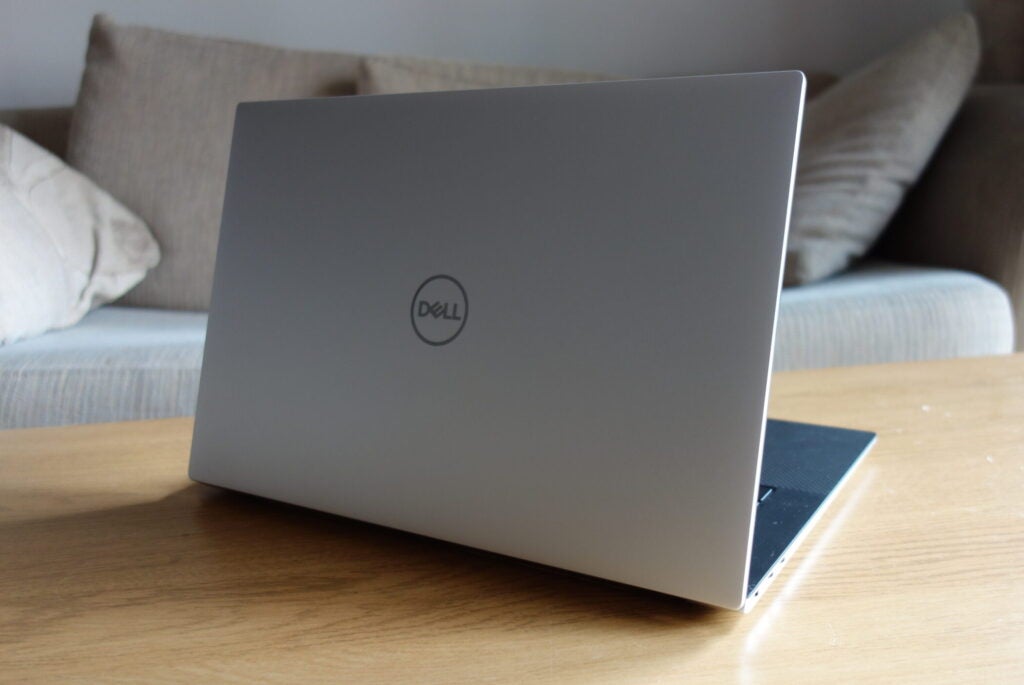
Of course, if you turn the resolution up to 4K battery life will take a hit. When turning the resolution up to Ultra HD and conducting the same test, the XPS 15 only lasted 6 hours and 29 minutes. That’s still a respectable result, but it’s wise to be mindful of its limited stamina if you’re watching Netflix or editing photos in Ultra HD.
You should buy the Dell XPS 15 (2020) if…
- You want a big laptop screen
This may sound obvious, but there’s no need in spending big on a 15-inch laptop if a 13-inch alternative could do the job for cheaper. Only consider the XPS 15 if you watch a lot of video or need the extra screen space for work.
- You’re craving a luxurious portable
The Dell XPS 15 is one of the best laptops you can buy with a top-class design. But it’s also very expensive, so you really need to be up for paying a premium.
- You want a laptop for work
Sticking to web browsing and social media is arguably wasting this laptop’s power. This is a fantastic system for those who want to blast through productivity tasks and engage in light media work.
You shouldn’t buy the Dell XPS 15 (2020) if…
- You want a gaming laptop
The Dell XPS 15 may be capable of gaming when configured with the GTX 1650 Ti, but its still not powerful enough to be running AAA games on the regular. You’re also limited to a 60Hz refresh rate here.
- You want a MacBook Pro alternative
While the XPS 15 can dabble with photo and video editing, it’s not on the same performance level as the 16-inch MacBook Pro. It’s best thinknig of this Dell as a productivity powerhouse rather than a multimedia wizard.
- You hate the dongle life
The Dell XPS 15 lacks a USB-A port, which means you’ll probably need to use the bundled adaptor whenever you want to hook up a mouse, keyboard or USB stick.
FAQs
Turn off the laptop and turn it upside down. Remove the ten screws at the laptop’s bottom, then open the XPS lid and remove the two screws underneath. Then lift off the backplate and remove the screws that secure the battery in place. Slowly lift the battery up, and gently pull the connector out of the motherboard socket. Then you can safely remove the battery. Be warned that this process will void your warranty.
It depends on the GPU you opt for a checkout. The max GPU option – the Nvidia 1650 Ti GPU – is capable of playing AAA in Full HD, but only at low graphics settings if you want a decent performance. Horizon Zero Dawn only hit a 38fps performance at ultra graphics settings during our testing, for example. The XPS 15 is no match for a proper gaming laptop.
Yes, we gave it a 4.5 out of 5 rating in our review, highlighting its stylish looks, gorgeous 4K screen and great battery life as its main strengths.
Specifications
How we test laptops
Unlike other sites, we test every laptop we review thoroughly over an extended period of time. We use industry standard tests to compare features properly. We’ll always tell you what we find. We never, ever, accept money to review a product.


